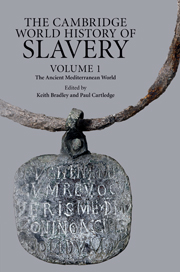Book contents
- Frontmatter
- Contents
- Series editors' introduction
- List of figures
- Acknowledgements
- Introduction
- 1 Slavery in the ancient Near East
- 2 Slaves in Greek literary culture
- 3 Classical Athens
- 4 The Helots: a contemporary review
- 5 Slavery and economy in the Greek world
- 6 The slave supply in classical Greece
- 7 Slavery and the Greek family
- 8 Resistance among chattel slaves in the classical Greek world
- 9 Archaeology and Greek slavery
- 10 Slavery in the Hellenistic world
- 11 Slavery and Roman literary culture
- 12 Slavery in the Roman Republic
- 13 Slavery Under the Principate
- 14 The Roman slave supply
- 15 Slave labour and Roman society
- 16 Slavery and the Roman family
- 17 Resisting slavery at Rome
- 18 Slavery and Roman material culture
- 19 Slavery and Roman law
- 20 Slavery and the Jews
- 21 Slavery and the rise of Christianity
- 22 Slavery in the late Roman world
- Bibliography
- General index
- Index of ancient passages cited
- Index of inscriptions and papyri
- Index of Jewish and Christian Literature Cited
22 - Slavery in the late Roman world
Published online by Cambridge University Press: 28 September 2011
- Frontmatter
- Contents
- Series editors' introduction
- List of figures
- Acknowledgements
- Introduction
- 1 Slavery in the ancient Near East
- 2 Slaves in Greek literary culture
- 3 Classical Athens
- 4 The Helots: a contemporary review
- 5 Slavery and economy in the Greek world
- 6 The slave supply in classical Greece
- 7 Slavery and the Greek family
- 8 Resistance among chattel slaves in the classical Greek world
- 9 Archaeology and Greek slavery
- 10 Slavery in the Hellenistic world
- 11 Slavery and Roman literary culture
- 12 Slavery in the Roman Republic
- 13 Slavery Under the Principate
- 14 The Roman slave supply
- 15 Slave labour and Roman society
- 16 Slavery and the Roman family
- 17 Resisting slavery at Rome
- 18 Slavery and Roman material culture
- 19 Slavery and Roman law
- 20 Slavery and the Jews
- 21 Slavery and the rise of Christianity
- 22 Slavery in the late Roman world
- Bibliography
- General index
- Index of ancient passages cited
- Index of inscriptions and papyri
- Index of Jewish and Christian Literature Cited
Summary
THE STATE OF THE QUESTION
The fate of slaves and slavery in the late Roman world is a subject that may be taken as a weather vane for prevailing trends in scholarship concerning late antiquity. The late third to fifth centuries were long regarded as an awkward appendage to the classical period, or a prequel to the mediaeval world, to be dealt with swiftly in both cases. Surveys of slaves and slavery tended to follow suit. Standard accounts of slavery in the Roman period characteristically ended with the Severans, leaving the Dominate well alone. When the late empire was discussed, it was as a period during which numbers of slaves declined drastically, either as a result of a significant reduction in external sources, or as an attendant to the more general economic stagnation of the period. The most elegant statement of this was Marc Bloch's (1947) posthumous article ‘Comment et pourquoi finit l'esclavage antique’, which argued for a growing tendency to settle slaves on land as tenants, rather than in the slave gangs of the early imperial period, and a coalescence of this group of agriculturalists with the large numbers of formerly free peasant proprietors and tenants, whose condition declined to one little short of slavery in the period. Similarly, Marxist scholars focused upon the problem of the transition from the slave to the feudal mode of production. The late Roman empire was considered a period during which the inherent limits of slave productivity became increasingly apparent.
- Type
- Chapter
- Information
- The Cambridge World History of Slavery , pp. 482 - 509Publisher: Cambridge University PressPrint publication year: 2011
- 7
- Cited by



